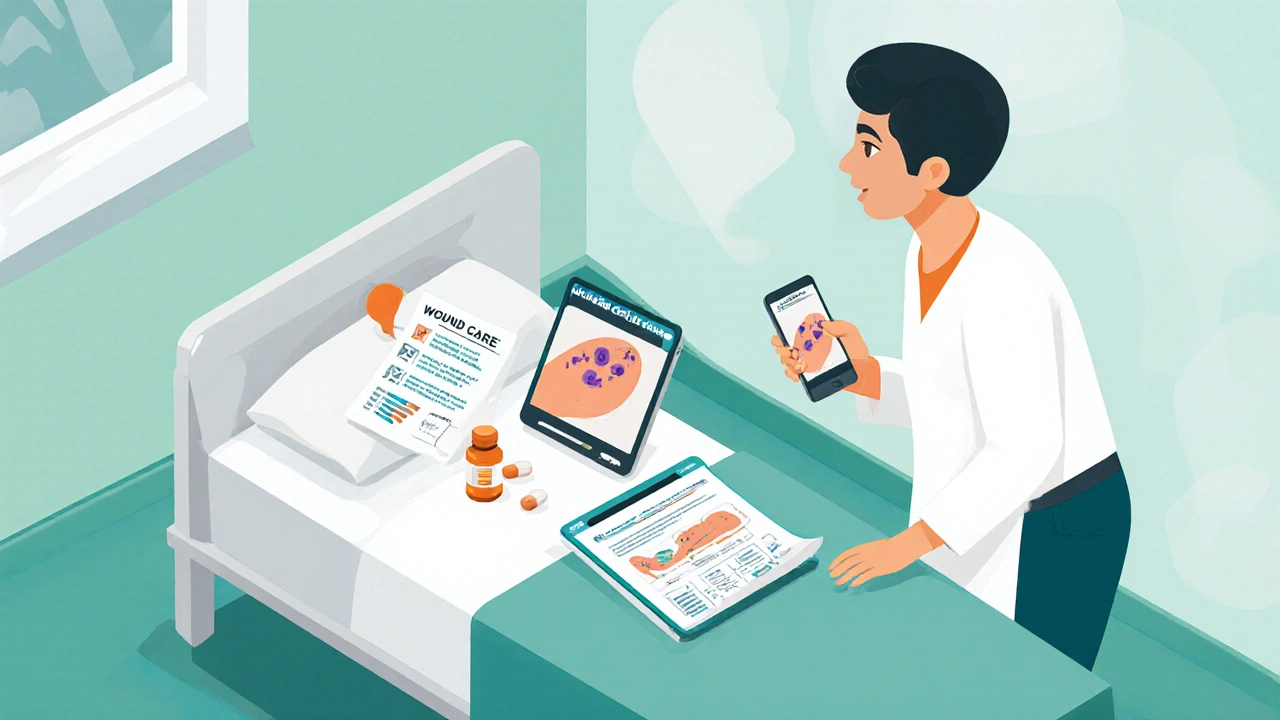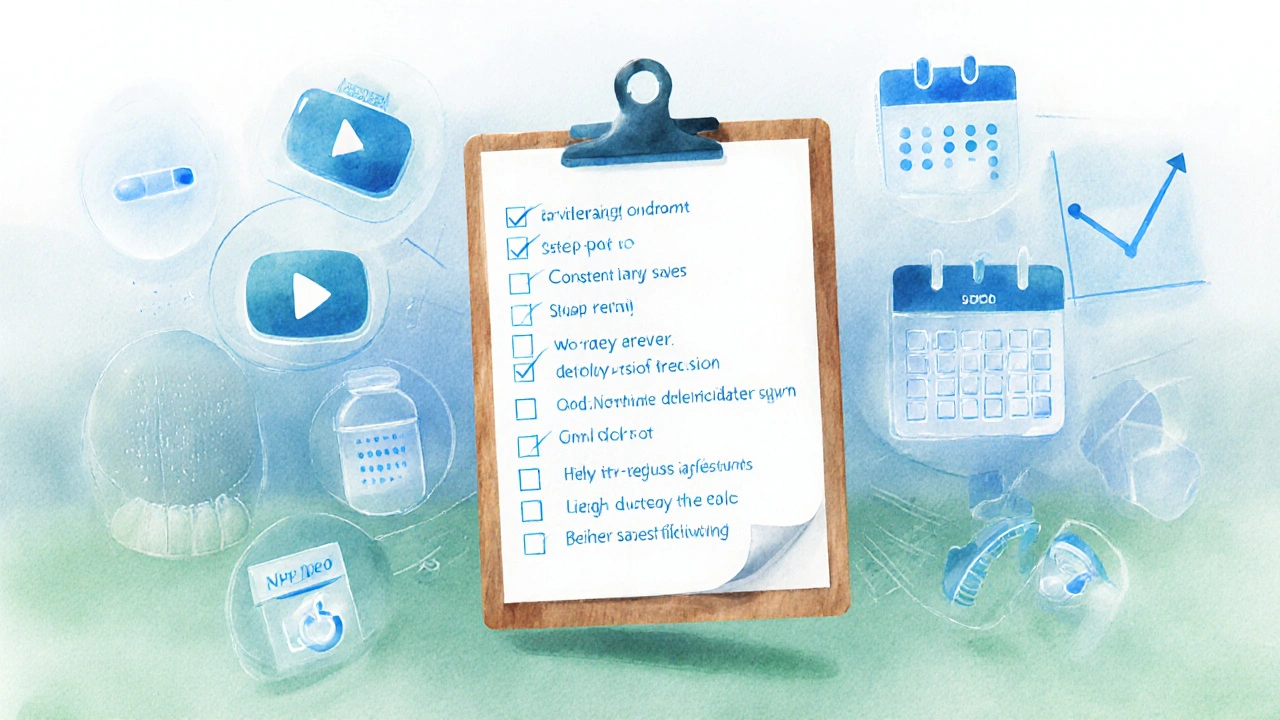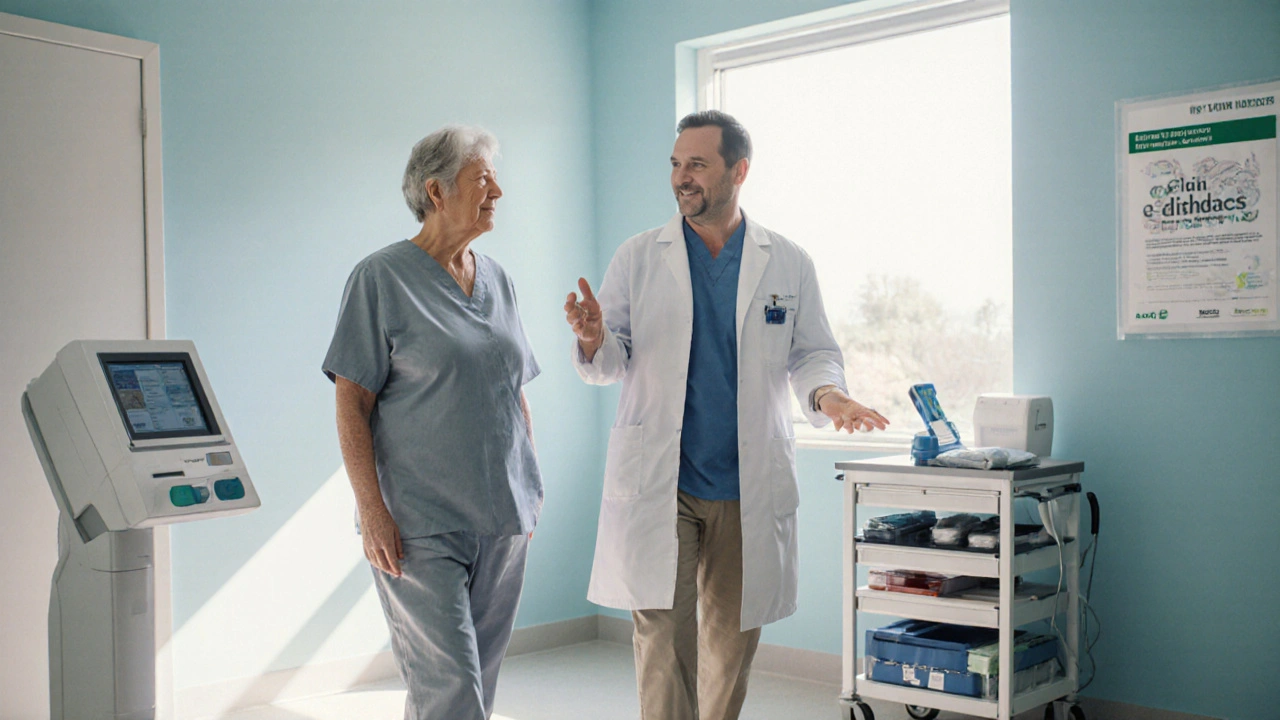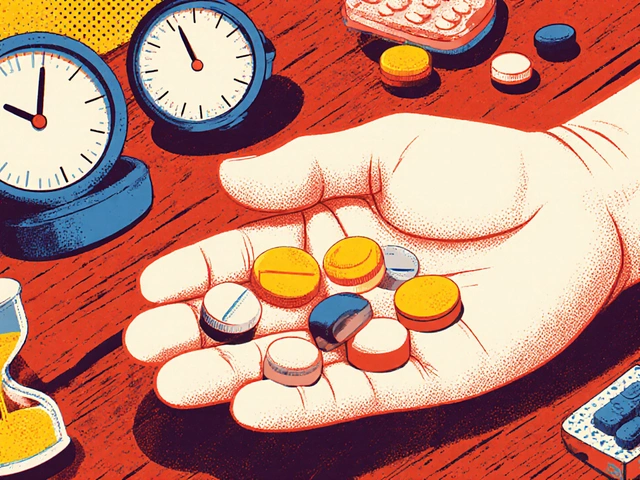Minor Surgery Education Planner
Pre-Operative
- Confirm patient's preferred language and literacy level
- Explain the procedure using plain language
- Review informed consent form
- Provide written handout covering preoperative instructions
Post-Operative
- Discuss pain-control plan and medication timing
- Demonstrate wound-care steps
- Highlight red-flag symptoms
- Schedule follow-up appointment
Recommended Education Plan
| Method | Pros | Cons | Cost (AUD) |
|---|---|---|---|
| Verbal (face-to-face) | Immediate feedback; personalized tone | Time-intensive; limited recall | $0-$5 per patient |
| Printed handouts | Tangible; easy to reference at home | May be ignored; literacy barriers | $0.50-$2 per copy |
| Digital (videos, apps) | Interactive; can include animations; reusable | Requires device access; maintenance needed | $50-$200 for development; negligible per use |
Recommendation: Use a blended approach combining verbal instruction, printed materials, and digital resources for optimal patient understanding.
When a patient walks into a clinic for a minor surgical procedure, the outcome often hinges on more than just the surgeon’s skill. Patient education is the systematic process of providing patients with the knowledge, skills, and confidence they need to manage their health before, during, and after a medical intervention. Without clear guidance, even a simple excision or skin tag removal can turn into an avoidable complication, a painful recovery, or a missed follow‑up.
Minor surgery is any surgical procedure that can be performed on an outpatient basis, typically under local anesthesia, with low risk and short recovery time. Because these procedures are quick and often done in a busy ambulatory setting, the window for thorough face‑to‑face teaching is narrow. That’s why a structured education plan is essential.
Quick Takeaways
- Effective education reduces complications by up to 30% in minor procedures.
- Combining verbal, written, and digital tools improves patient recall by 45%.
- A simple checklist ensures every key point is covered every time.
- Measuring outcomes (readmission, infection, satisfaction) validates the program.
Why Patient Education Matters in Minor Surgery
Patients who understand the purpose of the surgery, the steps involved, and what to expect afterward are far more likely to follow instructions. Studies from Australian hospitals in 2023 showed that patients who received comprehensive pre‑operative instructions experienced 25% fewer post‑operative pain spikes and 20% lower rates of surgical site infection.
Three core reasons drive the impact:
- Risk reduction: Clear guidance on wound care, activity restrictions, and signs of infection prevents avoidable setbacks.
- Enhanced compliance: When patients know why a medication or dressing change is needed, they are more likely to adhere.
- Patient empowerment: Knowledge builds confidence, reduces anxiety, and improves overall satisfaction scores.
Core Components of Effective Education
Good education covers three phases: pre‑operative, intra‑operative, and post‑operative. Each phase ties back to specific entities that should be defined early.
Informed consent is the documented agreement of a patient after receiving understandable information about the procedure, its risks, benefits, and alternatives. While consent is a legal formality, it doubles as the first educational touchpoint. Use plain language, visual aids, and ask the patient to repeat back key points.
Health literacy refers to the ability of individuals to obtain, process, and understand basic health information needed to make appropriate health decisions. Tailor the depth of information to the patient’s literacy level-ask about preferred language, use teach‑back, and avoid medical jargon.
During the pre‑operative visit, cover these preoperative instructions:
- Fasting requirements (if any).
- Medication adjustments (e.g., stopping anticoagulants).
- What to bring on the day of surgery.
- Expected timeline for the day.
In the intra‑operative moment, brief the patient on anesthesia type, positioning, and expected sensations. Even a quick “You’ll feel a pinch, then a warm sensation” can demystify the experience.
Post‑operative care is where most complications arise. Cover postoperative care is the set of instructions given after a surgical procedure, covering wound management, activity restrictions, medication, and follow‑up appointments thoroughly:
- Wound cleaning steps.
- Signs of infection (redness, swelling, fever).
- Pain management schedule.
- When to resume normal activities.
- Follow‑up timing and contact numbers.

Best Delivery Methods - What Works Best?
Patients have different learning styles. Providing information through multiple channels boosts retention. Below is a comparison of the three most common methods.
| Method | Pros | Cons | Typical Cost (AU$) |
|---|---|---|---|
| Verbal (face‑to‑face) | Immediate feedback; personalized tone | Time‑intensive; limited recall | 0-5 per patient |
| Printed handouts | Tangible; easy to reference at home | May be ignored; literacy barriers | 0.50-2 per copy |
| Digital (videos, apps) | Interactive; can include animations; reusable | Requires device access; maintenance needed | 50-200 for development; negligible per use |
In practice, a blended approach works best: start with a brief verbal overview, hand the patient a printed sheet summarizing key points, and follow up with a short video link they can watch at home. The video should demonstrate wound dressing, how to apply a cold pack, and when to call the clinic.
Building a Practical Patient Education Checklist
To avoid missing any critical detail, put the education steps into a checklist that staff can tick off for every minor surgery case. Here’s a ready‑to‑use template:
- Confirm patient’s preferred language and literacy level.
- Explain the procedure using plain language; ask the patient to repeat back.
- Review informed consent form; ensure signatures are obtained.
- Provide written handout covering preoperative instructions.
- Show the short instructional video (URL printed on handout).
- Discuss pain‑control plan and medication timing.
- Demonstrate wound‑care steps; give a wound‑care kit.
- Highlight red‑flag symptoms of surgical site infection is any infection that occurs at the site of a surgical incision, characterized by redness, swelling, warmth, pain, or purulent drainage.
- Schedule follow‑up appointment; provide a written reminder.
- Record patient’s questions and confirm satisfaction before discharge.
Printing the checklist and attaching it to the patient’s chart turns education into a repeatable process rather than an after‑thought.
Common Pitfalls and How to Avoid Them
Even seasoned clinics stumble when it comes to education. Spot the usual mistakes and apply the fix.
- One‑size‑fits‑all handouts: If the material is too generic, patients skim. Tailor handouts to procedure type (e.g., mole removal vs. cyst excision).
- Leaving out visual aids: Studies show visual cues improve recall by 60%. Include photos of a properly dressed wound.
- Assuming patients will remember everything: Memory fades after 24hours. Send a follow‑up text with a link to the video or a PDF reminder.
- Skipping teach‑back: Without confirming understanding, you risk non‑compliance. Ask, “Can you show me how you’ll change the dressing?”
- Neglecting cultural considerations: Some cultures avoid certain medications or dressings. Ask about cultural practices early.
Measuring Success - Outcomes and Metrics
When you implement an education program, you need data to prove it works. Track these key performance indicators (KPIs):
- Readmission rate within 7 days: Aim for <5% for minor procedures.
- Incidence of surgical site infection: Benchmark against national average (≈1.5%).
- Patient satisfaction score: Use a simple 1‑10 scale; target >8.
- Self‑reported compliance: Ask patients at follow‑up if they followed wound‑care instructions.
- Education completion rate: Percentage of cases where the checklist is fully ticked.
Review these metrics quarterly. If infection rates creep up, revisit the wound‑care video and handout clarity.

Frequently Asked Questions
What is the difference between minor surgery and a major operation?
Minor surgery is usually done on an outpatient basis, uses local anesthesia, and has a quick recovery. Major operations often require general anesthesia, hospital admission, and longer post‑operative care.
How can I make sure my patient understood the discharge instructions?
Use the teach‑back method: ask the patient to repeat the steps in their own words or demonstrate the wound‑care technique. Document the response on the checklist.
Are digital videos really necessary for simple procedures?
They aren’t mandatory, but videos boost retention, especially for visual learners. A 2‑minute clip can replace a lengthy verbal recap and can be re‑watched at home.
What signs should prompt a patient to call the clinic after a minor surgery?
Increasing redness, swelling, warmth, pus, fever over 38°C, or severe throbbing pain are red‑flags for a possible surgical site infection. Advise them to call immediately.
How often should the education checklist be reviewed?
Audit the checklist quarterly. Update language, visuals, or digital links based on patient feedback and outcome data.
By embedding education into every step of the minor surgery pathway, clinics can cut complications, boost patient confidence, and ultimately deliver better health outcomes.






Kartikeya Prasad
October 3, 2025 AT 20:13Wow, because reading a handout is *so* thrilling, right? 😏
HARI PRASATH PRASATH
October 4, 2025 AT 01:46Listen, if you skip the checklist you’re basically gambling with a patient’s recovery – that’s not just lazy, it’s reckless. Make sure every point is ticked, or you’ll see complications sooner than you think.
Andrew Miller
October 4, 2025 AT 07:19Reading about wound‑care makes me think of all the times I’ve felt helpless watching strangers recover.
Brent Herr
October 4, 2025 AT 12:53Patients who ignore post‑op instructions are the real villains here; they choose pain over responsibility and demand miracles from clinicians.
Julius Adebowale
October 4, 2025 AT 18:26Data shows compliance improves when instructions are clear
KISHORE KANKIPATI
October 4, 2025 AT 23:59Imagine a patient walking out feeling like a superhero because they finally understand how to care for their own wound – that’s the magic we’re aiming for.
Jefferson Vine
October 5, 2025 AT 05:33Behind every “simple” excision lies a hidden agenda of pharma companies pushing meds you don’t really need – stay vigilant and question every prescription.
Ben Wyatt
October 5, 2025 AT 11:06Education is the cornerstone of any minor surgical pathway.
When a patient knows what to expect before the scalpel touches skin, anxiety drops dramatically.
Clear pre‑operative instructions reduce the need for last‑minute phone calls on the day of surgery.
Written handouts act as a safety net for patients who forget verbal advice after leaving the clinic.
Digital videos reinforce the steps with visual cues that many adults retain better than text alone.
Combining these methods creates redundancy that catches gaps in understanding.
The teach‑back method, where patients repeat instructions in their own words, confirms true comprehension.
Studies from Australian hospitals in 2023 reported a 30% drop in complications when education checklists were used.
Follow‑up texts with links to wound‑care videos further cut readmission rates by about ten percent.
Pain control schedules explained in plain language prevent under‑dosing and opioid misuse.
Highlighting red‑flag symptoms empowers patients to seek help before infections spiral.
A simple color‑coded dressing guide can be understood even by low‑literacy individuals.
Scheduling the next appointment before discharge eliminates the “I’ll just call later” excuse.
Auditing the checklist completion rate each quarter helps clinics spot systematic failures.
Ultimately, a well‑educated patient becomes a collaborator in their own recovery, leading to smoother outcomes and higher satisfaction.
Donna Oberg
October 5, 2025 AT 16:39Oh my god, the sheer amount of vital info that gets tossed at patients-clinical jargon, dosage charts, wound‑care steps-it's overwhelming, and yet we dare to call it “simple”!!!
Garreth Collard
October 5, 2025 AT 22:13As I sip my coffee, I can’t help but picture the poor soul clutching a cheap pamphlet, dreaming of a painless recovery that never comes because no one bothered to make the video sparkle with cinematic flair.
Daniel LaMontagne
October 6, 2025 AT 03:46I totally get how confusing all those instructions can be 🙌, so here’s a quick tip: keep the wound clean, change the dressing daily, and call if you see any redness or swelling 🌟.
Gary Levy
October 6, 2025 AT 09:19One practical tweak is to add a QR code to the printed handout that links straight to the instructional video, making it effortless for patients to revisit the steps at home.
sourabh kumar
October 6, 2025 AT 14:53Skip the fluff and just follow the steps
Christian Miller
October 6, 2025 AT 20:26Given the increasing surveillance of medical data, one must consider that standardized education modules could be repurposed for unintended analytics, therefore transparency is essential.
NORMAND TRUDEL-HACHÉ
October 7, 2025 AT 01:59Honestly, if you can’t read a one‑page sheet, maybe surgery isn’t for you.
AJIT SHARMA
October 7, 2025 AT 07:33Our clinics need to follow the best practices from the homeland, not borrow foreign ideas that don’t work here.
Neber Laura
October 7, 2025 AT 13:06The claim that only “homegrown” methods work ignores the global evidence showing blended education cuts infections.
Dean Briggs
October 7, 2025 AT 18:39While the bluntness of such a statement might echo a certain frustration, it also reflects a deeper philosophical tension between elitist gatekeeping and inclusive patient empowerment; when we dismiss patients based on literacy we undermine the very ethic of care that medicine purports to uphold; education, after all, should be a bridge, not a barrier, inviting every individual regardless of background to participate actively in their healing journey; by cultivating humility and curiosity we can transform the surgical encounter into a collaborative partnership; the paradox lies in recognizing that true expertise is demonstrated not by who talks the most, but by who listens most attentively; therefore, let us replace sarcasm with sincere effort to demystify procedures; only then will we honor the trust patients place in us.
Sadie Speid
October 8, 2025 AT 00:13Great point! Let’s keep pushing for evidence‑based education that benefits everyone 😊.